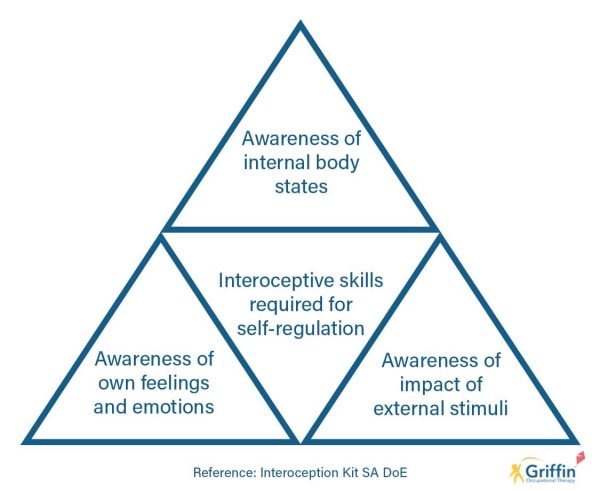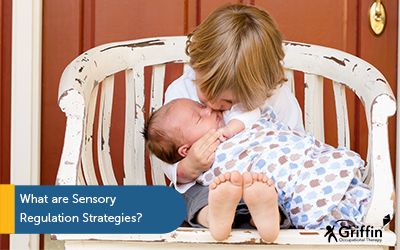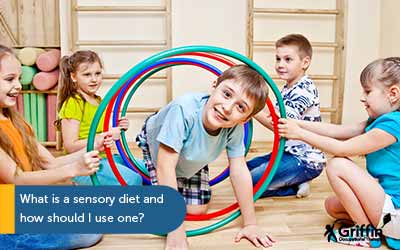Processing internal sensations
Interoception refers to the internal sensory messages that the brain receives from the body. These sensory messages come from our organs and internal receptors. They let our brain know about things like hunger and internal pain, such as a headache. In this post I will explore
Processing internal sensations

Interoception refers to the internal sensory messages that the brain receives from the body. These sensory messages come from our organs and internal receptors. They let our brain know about things like hunger and internal pain, such as a headache. In this post I will explore
What is interoception?
Interoception is the internal sensory feedback the brain receives from the body. It tells the brain about what’s going on inside the body. This includes messages from our organs, hormones and immune system. There are also internal receptors in the skin.
Interoception helps us to understand the body’s internal state. It includes sensory messages about
Internal vs external sensory messages
Unlike the smell or hearing senses which process external information in the environment, interoception processes internal body messages.
Our nose picks up scents in the environment and our ears hear sounds. But, if we have a cold or ear ache, it is our interoceptors that senses internal pain and discomfort. It’s the same with stomach pain or headache, the interoceptors tell the brain that there is discomfort.
The sense of touch is slightly differently as it has receptors for both external and internal sensations. As an example, the external skin will feel if the outside side temperature is hot. But, our interceptive sense receives internal messages which identify if we are getting too hot and need to start sweating to help control our temperature. It also identifies if we running a temperature because that is an internal message from the body.
When we have good interoceptive awareness, we also notice the impact that an external sensory message has on our internal state. For example, I know if I get lost when I am driving, my stress level increases. If the radio is on, I become even more stressed. If I turn the radio off, this helps to lower my stress level and arousal. The external sensory messages from the radio do not help my internal state. In order to be able to self-regulate, we need to be aware of the internal messages from our organs as well as the meaning (or emotions) we have associated to these.

Processing interoception – a comparison
Sarah and Tim were playing spaceships. Their costumes were very hot. After running around ‘on the moon’ a for bit, both children were getting hot. However, they had different reactions. Tim did not notice he was getting hot. He was becoming quickly frustrated with Sarah when she moved close to him and could not stay focussed on their story.
Sarah noticed she was starting to feel hot and bothered. She suggested they take a break and went to get a cool drink. Then, she sat down and opened up her space suit to help her to cool down. Sarah paid attention to her interoceptors. She listened to her body’s internal messages and changed her behaviour to match her internal needs.
However, Tim was not noticing the sensory messages from his interceptors. He did not notice he was getting hot and frustrated. This meant he did not change his plan. Luckily, he agreed to have a break with Sarah. This helped him to cool down and they then continued their game.
Where do the interoceptive messages come from?
Interoception receives sensory information from the organs, primarily via nerve called the vagus nerve. This includes information from the stomach, lungs, kidneys, bladder, heart and intestines. The information may let the brain know that the organ is full (e.g. stomach when you have eaten too much). It also lets the brain know how the organ is working (e.g. if the heart is beating quickly or slowly). Or, as mentioned above if there is pain.
This sense also processes hormones and neurotransmitters. These are little chemicals which move around the body via the blood and other fluids in the body (e.g. the special fluid which surrounds our brain). They have a big impact on our levels of alertness and how our body functions.
There are also interoceptive receptors in the skin which give additional information. If you want to understand more about how the these messages arrive at the brain, this Wikipedia post explains it well.
Interoception – why it’s important to understand our internal state
Historically, we have focussed a lot of attention on the senses that process external information and movement. However, these only tell the brain the part of the story. The internal messages from our body provide another, very important, piece of the puzzle.
Interoception is the foundation from where we can process all of our other senses. It is the sense that helps us to regulate our body’s needs. If we are tired, it is much harder to focus. When we are really stressed, our ability to make decisions can be impaired.
If, like Tim, we don’t notice these changes in state or arousal, then we don’t make appropriate changes. Understanding our internal state is what helps us to make changes. Interoception is the key to understanding those internal sensations.


Have you ever been Hangry?
‘Hangry’ is a great term which is essentially describing the result of poor internal regulation. If you’re not familiar with it, it is a portmanteau of Hungry and angry. It is the internal dysregulation, sometimes expressed as anger or abruptness, which occurs when someone is hungry.
The best solution to hangriness is to eat! An even better solution would be to be more aware of the interoceptive signals of hunger before you became hungry. However, sometimes when we are engrossed in something or busy, we don’t listen to interoception. We ignore those internal messages until it is too late. Then our hungriness turns to short temperedness.
Interoception and self-regulation
Processing of interoception is essential to self-regulate. Regulation is the ability to make changes to keep our body in an organised state. Self-regulation is the ability to notice and do this by ourselves. For example, noticing we are hot and taking our jumper off. Or, noticing we are becoming a bit stressed and taking a walk or doing five minutes of slow breathing.
If we are not aware of the body’s internal signals, we will never take steps to change them. Or, we might be too late to make changes. For example, the child who doesn’t realise they need the toilet until the last minute and then doesn’t make it. Or, the adult who doesn’t recognise their frustration increasing who says something they regret.
This is why interoception is so important! The sooner we are aware of those signals, the sooner we can make changes. The sooner we can correctly identify these signals, the sooner we can make the right changes.
Sensory processing, autism and interoception
More and more interoception is being included in any literature or training linked to sensory processing. In my experience, children who are slower to process external sensations are often slower to process internal sensations as well. Sometimes they are just not aware of the internal sensations. They might not notice pain until it is significant. So, they don’t feel the ear ache coming on, they only feel the ear ache when it is completely infected.
Some children who experience sensory overload can sometimes have a small window where they need to identify interoceptive messages. Others ignore the messages. This means they also don’t take steps to help with self-regulation and this leads to their overload. Often, they become so used to ignoring those messages that they need to relearn how to respond to them appropriately.
Interoception is all about what is going on inside. Sometimes we look for complex reasons, but actually it may be a simple answer like the child is hungry. Children need help initially to identify these messages and make changes, but over time we learn to self-regulate.
Attention, learning and interoception
Like all of the senses, awareness or lack of awareness of the interoceptive sense can have a big impact on attention and focus, and subsequent ability to participate and engage.
When the interoception sense isn’t being processed accurately, children may appear to have an emotional reaction without any warning. This is especially important to consider for children who are non-verbal or who have reduced communication as they have even less capacity to explain what is happening.
Or, they may not be able to pay attention to learning because they are hungry, needing the toilet or stressed. When these sensations aren’t recognised they can sometimes be treated by adults as ‘bad behaviour’. However, treating them with a behaviour approach won’t help. If a child is hungry, the only helpful solution will be to feed them!
Take your knowledge further
In this half an hour video, Dr Emma Goodall explains interoception in even further depth.
Supporting children with interoception
My second article on interception explores how to help children with their interoceptive awareness. You can read it here: Helping children with interoceptive awareness.



